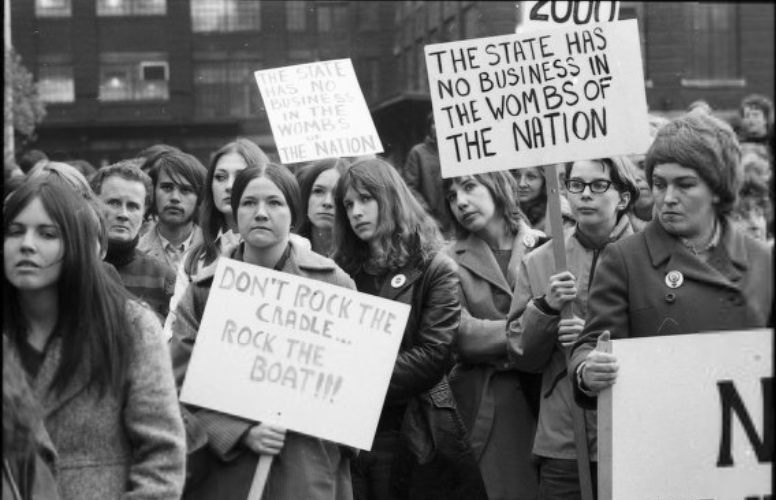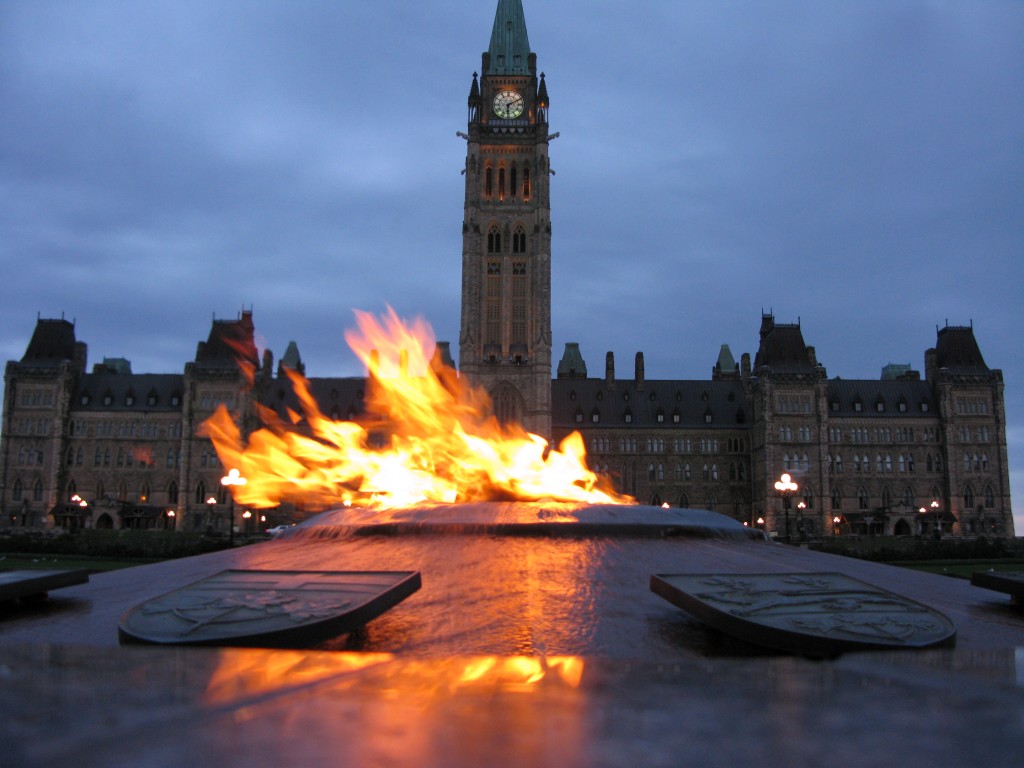On Saturday, May 9, 1970, following a rally on Canada’s Parliament Hill, between 150 and 300 protesters marched to Prime Minister Pierre Elliott Trudeau’s residence. The group carried signs that read “The State Does Not Belong in the Uterus of the Nation” and “We Are Furious Females,” and shouted chants such as “Up from the kitchen! Up from the bedroom! Up from under! Women unite!” Once they arrived at the Prime Minister’s residence, the women pushed past the few Royal Canadian Mounted Police guards and assembled on the front lawn. After negotiations with the RCMP, the women agreed to leave on the condition that they were allowed to place the coffin they had carried with them from Vancouver, which was symbolic of the deaths of women from illegal abortions, on the Prime Minister’s doorstep. As they placed the coffin, one woman made a speech about the tools of the illegal abortionist and how each one contributed to the death of Canadian women.
This protest was part of the Abortion Caravan, one of the first actions undertaken by a growing, national pro-choice movement in Canada. Garnering significant media and political attention, the Abortion Caravan acted as a consciousness raising tool that authorized women to speak publicly and with authority about their experiences under Canada’s restrictive abortion laws even as it empowered them to challenge these laws.

The Abortion Caravan registered women’s anger at the so-called modernization of Canada’s abortion laws. Since the late 19th century, abortion was illegal except for a vague “saving” clause that allowed physicians to perform abortion to save the life or health of the pregnant woman. The Canadian Medical Association and the Canadian Bar Association, alongside numerous politicians, clergy, and individual citizens, advocated for reform throughout much of the 1960s. Under the liberal government of Prime Minister Trudeau, a 1969 omnibus bill made several changes to the Criminal Code of Canada, including decriminalizing consensual homosexual acts and birth control, and liberalizing the abortion law. The new legislation allowed for abortion when a licensed physician performed it in an accredited hospital with approval by a committee comprised of at least three doctors who determined that the pregnancy endangered the life or health of the pregnant woman. For members of the Caravan, these reforms did not go nearly far enough and prevented most women from electing to have abortions.
As an historical moment, the Abortion Caravan represented much more than a call for decriminalized abortion. It also represented a repudiation of sexism in Canadian culture including politics in general and the New Left in particular. Many of the Caravan participants had a history of involvement in protest organizations–-student, New Left, anti-Vietnam War, Civil Rights—that were male dominated. In the context of struggling for social justice, these women continued to experience the sexism that permeated Canadian society. Their growing awareness and dissatisfaction with these conditions radicalized them. Planning a national protest in favour of abortion rights enabled women to step out from supporting organizational roles, register their rejection of the new abortion law, and draw attention to pervasive sexism.
The Caravan both resulted from and was a part of the women’s consciousness raising and radicalization. Beginning on the west coast in Vancouver, British Columbia, the Abortion Caravan travelled across the country to Ottawa, the nation’s capital. On the way, it made stops in major cities and towns to educate the public, connect with other women’s groups, and gather supporters for the public protests to take place in Ottawa. As one Caravan participant observed, “The abortion issue lent itself very easily to a focused mobilization. As we radicalized, we were thinking what had big control over our lives – men, the media, advertising, and the state. Abortion was a great example of something you could go after the state on.” The women who planned and participated in the Abortion Caravan turned their back on liberal activism, embracing instead a radical approach. Speaking with other women about their experiences with unplanned and unwanted pregnancies and of the inadequacy of available solutions further politicized participants.

The Abortion Caravan’s theatrical protest on Parliament Hill drew widespread attention to the harms of Canada’s new abortion law, dramatically publicizing the private struggles women faced when seeking abortions. The Caravan arrived at Parliament Hill–-its final destination–-on Monday, May, 11. Approximately 80 women, holding placards and shouting chants, circled the Centennial Flame and listened to speeches. Describing the protest, the Montreal Gazette reported, “Donning red bandanas, they chanted ‘No more women will die’ and ‘Free abortion on demand’ and then listened to one of their leaders tell them: ‘We will no longer permit irresponsible male legislators to use this law to repress us. The women of Canada answer with fire.’” One protester burned a “large parchment” upon which was written the relevant section of the Criminal Code because the women “no longer recognize laws that destroy rather than protect lives.”
The Abortion Caravan sought to place women’s voices at the center of national debate. To do so, these women spoke out in Canada’s Parliament, the very institution in which (mostly) male politicians exercised control over women’s reproductive lives. While their sisters protested outside, 36 protesters entered the House of Commons and sat in the Members and Opposition galleries, having obtained and forged passes to both. Once inside, several women chained themselves to their seats. One protestor managed to connect a microphone to the simultaneous translation box at her seat, which would give her voice added strength once the protest began. Each sat with her portion of a speech that had been prepared the night before. Then, at approximately 3:00 pm the first woman stood and began to read her excerpt of the speech. One newspaper described the protest this way: “The women rose at first one at a time and were physically removed from the galleries by Commons guards; but eventually they rose in unison to chant ‘free abortion on demand.’” Other slogans included: “we demand free abortion,” “we want control of our bodies,” “no more women will die,” and “they have killed 2,000 of our sisters.” Once it became clear that removing the women would take some time, given the necessity of cutting through chains, the Speaker of the House recessed the session, which was unprecedented. By claiming that space, however briefly, the women exerted their authority over and expertise on their reproductive lives and needs.
Media coverage of the Abortion Caravan’s actions increased public awareness of the limits of the new abortion law and empowered women to speak out as authorities about their own bodies. Repeatedly in letters to the editors of newspapers and magazines and to government bodies, women throughout the 1960s expressed frustration with the fact that the voices most often heard–-and listened to–-on abortion were those of men. By placing themselves in the House of Commons where parliamentarians debated and voted on the abortion law, these women literally inserted themselves into the center of political discussion.
While some politicians criticised the women in the Abortion Caravan as naïve and lacking an understanding of the “democratic process,” the women in fact rejected that process. When the 1969 liberalization of the abortion law came about, many commentators viewed it as protecting doctors from prosecution rather than satisfying women’s demands for greater reproductive autonomy. Elsewhere I have examined how countless Canadian women wrote letters to the editors of magazines and newspapers, to government bodies and officials, asking for an abortion law that was responsive to their reproductive needs. The Abortion Caravan was a declaration that the government and the abortion laws it had passed lacked legitimacy.
The efficacy of the Abortion Caravan wasn’t immediately apparent; no legal changes would occur for an additional 18 years. But, and perhaps more importantly, the participants credit the Caravan with bolstering women’s confidence as political actors and organizers, drawing women into a national abortion rights movement, and making abortion a subject about which women could speak publicly. The Caravan brought abortion into the open, especially in those places where the Vancouver Women’s Caucus stopped and held public meetings. Their actions throughout the Abortion Caravan demonstrated that they no longer had tolerance for the idea of reform, but demanded “free abortion on demand” and refused to have their right to do so questioned.
 Shannon Stettner teaches in the Women’s Studies department at the University of Waterloo. She recently co-edited a special issue on reproductive health history in Canada for the Canadian Bulletin of Medical History. She is one of the founding co-ordinators of the Abortion: The Unfinished Revolution conference, held last year in Charlottetown, Prince Edward Island. Her research focuses on reproductive health, especially the history of abortion in Canada, women’s health activism, oral history, and the media and women’s rights. Shannon tweets from @slstettner.
Shannon Stettner teaches in the Women’s Studies department at the University of Waterloo. She recently co-edited a special issue on reproductive health history in Canada for the Canadian Bulletin of Medical History. She is one of the founding co-ordinators of the Abortion: The Unfinished Revolution conference, held last year in Charlottetown, Prince Edward Island. Her research focuses on reproductive health, especially the history of abortion in Canada, women’s health activism, oral history, and the media and women’s rights. Shannon tweets from @slstettner.

NOTCHES: (re)marks on the history of sexuality is licensed under a Creative Commons Attribution-NonCommercial-NoDerivatives 4.0 International License.
Based on a work at www.notchesblog.com.
For permission to publish any NOTCHES post in whole or in part please contact the editors at NotchesBlog@gmail.com





Thanks for this post, and thanks for bringing Canadian content to Notches! I understand that Canada has had no legal restrictions on abortions since R v Morgentaler in 1988, which you allude to in your post. But not knowing the trajectory leading up to that case myself, I was wondering what influence you thought the Abortion Caravan and its consciousness-raising efforts had on fostering a social/cultural landscape in Canada in which R v Morgentaler could happen. Or was the case more of a straightforward Charter issue? Basically, I’m eager to hear more about the long-term impacts of the Caravan. Thanks!
Thanks, Justin. That’s an interesting question because in recent years the Abortion Caravan has garnered a lot of attention (from both academics and the media) whereas for many years it wasn’t a particularly well remembered or studied event. One of the outcomes of the renewed interest has been to overemphasize its direct or long-term importance. As I said in the post, I think it was very important in terms raising consciousness and giving the participants confidence as political actors and organizers – it was a radicalizing moment, but in terms of its impact on the 1988 Supreme Court decision, I don’t think it had much of a direct influence.
Trudeau didn’t meet with the women when they came to Ottawa in May 1970, but in June 1970 he met with several women from the Vancouver Women’s Caucus when he passed through Vancouver. His comment to them was “It is your job to change public morality. The public is not ready for this [removal of abortion from Criminal Code].” So, for the next 18 years, that was one of the (many) goals of the women’s movement – which is why you see a shift in messaging from “free abortion on demand” to demanding a “right to choose” – it was a more “sellable” message. The women’s movement also closely worked with Dr. Henry Morgentaler, who challenged the abortion law by establishing abortion clinics when it was illegal to do so. As you indicated, the 1988 Supreme Court decision saw the 1969 law struck down because it contravened the Charter – so the Canadian Charter of Rights and Freedoms (1982) was absolutely crucial to that victory – but I personally feel like the women’s movement’s doesn’t get enough credit for its role in that victory. Yes, Morgentaler (and other doctors) directly challenged the abortion law, but those challenges were supported by the women’s movement both financially through fundraising and in terms of gaining the public support that Trudeau indicated was necessary. Probably the best book on the 1988 challenge is The Politics of Abortion by Brodie, Gavigan, and Jenson.
An interesting postscript to this renewed attention on the Abortion Caravan is that the anti-abortion movement in Canada has attempted to co-opt the Caravan. In 2012 they came out with the “new abortion caravan” that retraced the steps of the original Caravan – except this time their goal was to “show the truth” about abortion. Apparently they have an 18-year plan to make abortion unthinkable. Even the anti-abortion movement has its own take on the Caravan’s legacy and so it has continued or renewed relevance on both sides of the issue.
Thanks for this further information! I was fascinated to read Trudeau’s comment that “It is your job to change public morality.” He sounds very pragmatic; more so than I had realized. Those kinds of politics are interesting to me as well in relation to my research into 1950s/60s homosexual law reform campaigners in Britain. It’s very clear that my subjects had no illusions that the necessary precursor to legal change was slow (even incremental) social change; unlike later radicals, the individuals I study explicitly had the long game in mind.
Your postscript is a fascinating point as well, and I just wanted to say that we’d welcome another piece down the line that puts this more recent action, and their 18-year plan, into historical perspective.
I’ve heard reactions from some of the women present at the meeting with Trudeau – pragmatic is a much less colourful word than they used! I’m not sure how it was with the people you study, but for some (many?) of the women there’s a disillusionment that happens. In interviews, women described the “headiness” of the Abortion Caravan happening at the same time as massive anti-war demonstrations (following the Kent State shootings) – there seemed to be momentum…but then no immediate change – hence the focus on slower social change.